|
|
| Spot |
| Site of Osaka Jikei Hospital | 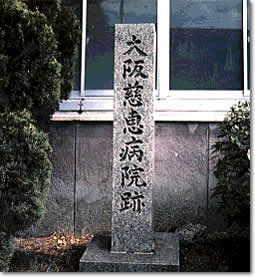 |
| Location: 2-3-66 Ikuno-Higashi, Ikuno-ku (Ikuno Industrial High School) | |
| Access: Bus station Ikuno Industrial High School | |
| Osaka Jikei Hospital was founded in June 1888 by Takahashi Masazumi, Ogata Korenori and other doctors with the help of many philanthropists to provide medical care for the poor. The hospital was started in Enkoji Temple (in Karamono-cho, Chuo-ku) and was gradually expanded, relocating from place to place. The hospital was made a part of the medical institution Kosaiin in 1913 and relocated to this site in 1924. The hospital buildings burned down during the air raids in 1945. Jikei Hospital remains affiliated with Kosaiin in Furuedai, Suita City. |
| Site of the Yokono Shrine | 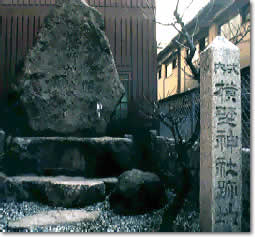 |
| Location: 3-9 Tatsumi-Nishi, Ikuno-ku | |
| Access: 10 minutes walk to the northwest from Subway Sennichimae Line,Minami Tatsumi Station | |
| This small hill was the location of the
Yokono Shrine until 1907, when its deity was enshrined in the Tatsumi
Shrine. The Yokono Shrine was formerly called Injino Miya, and its
record appears in Engishiki, an early Heian period (10th century)
historical document. The Yokono Shrine is said to be dedicated to the guardian deity of the Yokono Embankment. According to "Nihon Shoki," Emperor Nintoku started in the 11th year of his reign (320 A.D.) a series of civil engineering projects including the excavation of canals and construction of embankments to increase arable land for the people. In 322, the Emperor constructed the Yokono Embankment around here and built Tsurunohashi the next year. |
| Monument to Kusunoki Masanaga and Park | 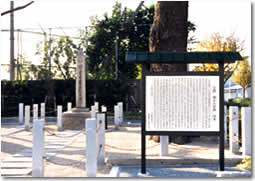 |
| Location: 4-2 Tatsumi-Minami, Ikuno-ku | |
| Access: 2 minutes walk to the south from Subway Sennichimae Line Minami Tatsumi Station | |
| In the park stands a monument to Kusunoki
Masanaga, who lived here as a priest of the Tenjin Shrine in which
the tutelary deity of Shijo Village and the Kusunoki clan was enshrined. Masanaga was born in 1372 as a grandson of Kusunoki Masashige (1294 - 1336), the great warlord who fought for the Southern Dynasty. Masanaga refused an invitation from the victorious Northern Dynasty and lived the simple life of a rustic priest of the Tenjin Shrine in Shijo Village performing services for the departed souls of his ancestors. Later he turned to Buddhism of the Hongan-ji sect. He was given the Buddhist name of Jogan by Abbot Kojo of Hongan-ji, and built Jogan-ji Temple, which remains to this day at 1-10-10 Tatsumi-Minami. There is a wooden statue of Masanaga in Jogan-ji Temple. |
| Tomb of Priest Suigan | 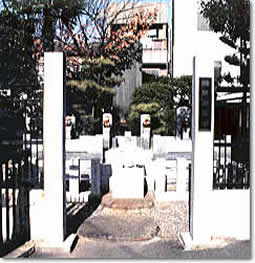 |
| Location: 2-7 Nakagawa, Ikuno-ku | |
| Access: 6 minutes walk to the west from subway Shoji Station | |
| This is the resting place
of Sumiyoshiya Tarozaemon (known by his Buddhist name Suigan), who
was a great philanthropist and benefactor to Nakagawa Village, where
he was born about 300 years ago. Suigan built 11 bridges in the neighboring districts, constructed and improved roads, donated to shrines and temples and gave rice to the needy. He spent his own funds on innumerable public undertakings. A plot of land donated by Suigan is still owned by the town of Nakagawa and is used for the welfare of the inhabitants. At the gate of the tomb is placed a piece of stone with which Suigan built one of the bridges, as a reminder of his good deeds. |
| Site of Tatsumi Village Office | 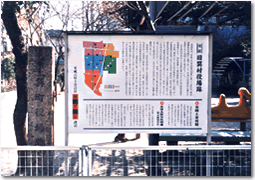 |
| Location: 3-18 Tatsumi-Naka, Ikuno-ku | |
| Access: 3 minutes walk to the east from the bus station Tatsumi Kosetsu Shijomae | |
| The site of Tatsumi Village
Office is now a children's park across the street to the east from
Tatsumi Elementary School. In 1889 when the municipality system was enforced, five villages of Yagara, Iga, Nishiashiro, Shijo and Daichi were merged to form Tatsumi Village, the name being derived from the fact that the village was to the southeast (tatsumi in archaic Japanese) of Osaka Castle. The village office was at first in Daichi, together with the elementary school. It was relocated here in 1918 and served the inhabitants as village office until 1948 and as Tatsumi Town Office until 1955, when the town was merged into Osaka City and the office was demolished. This area is now densely built up with houses and apartments served by the Inner Loop Line and the subway, but 50 years ago the landscape was quite pastoral with Mt. Ikoma in the east and Mt. Rokko to the west. |